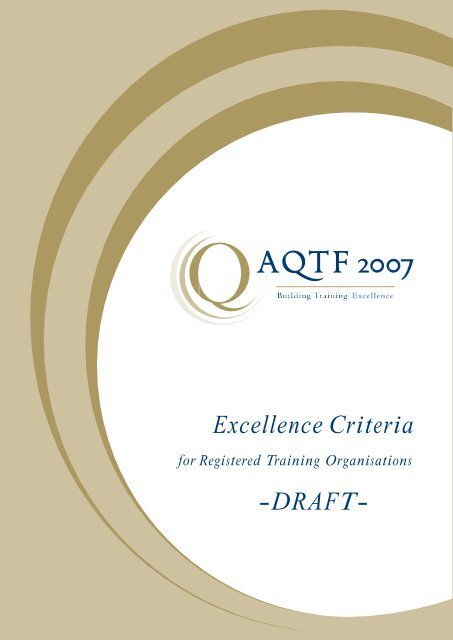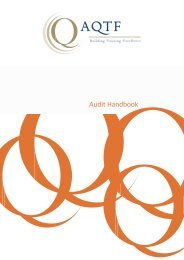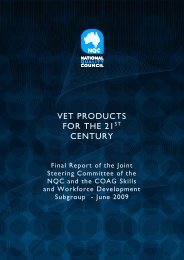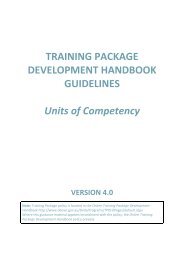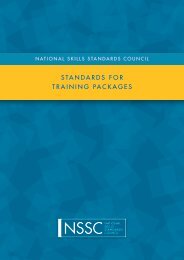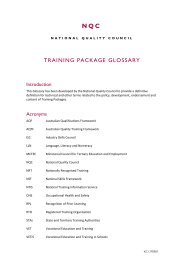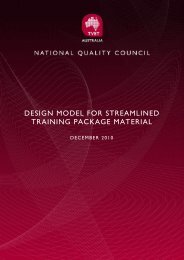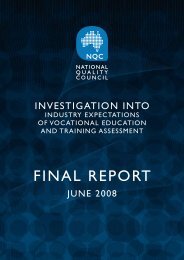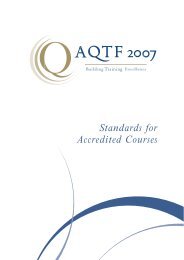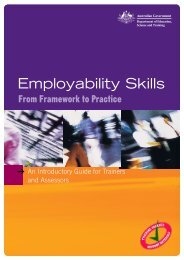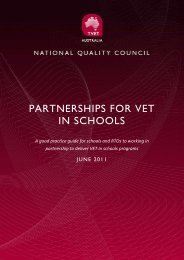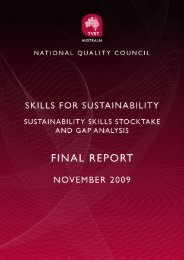AQTF 2007 Excellence Criteria for RTOs. - National Skills Standards ...
AQTF 2007 Excellence Criteria for RTOs. - National Skills Standards ...
AQTF 2007 Excellence Criteria for RTOs. - National Skills Standards ...
You also want an ePaper? Increase the reach of your titles
YUMPU automatically turns print PDFs into web optimized ePapers that Google loves.
<strong>Excellence</strong> <strong>Criteria</strong><br />
<strong>for</strong> Registered Training Organisations<br />
-DRAFT-
<strong>Excellence</strong> <strong>Criteria</strong><br />
<strong>for</strong> Registered Training Organisations<br />
-DRAFT-
With the exception of the Commonwealth Coat of Arms and where otherwise noted all material presented in this<br />
document is provided under a Creative Commons Attribution 3.0 Australia<br />
(http://creativecommons.org/licenses/by/3.0/au/) licence.<br />
The details of the relevant licence conditions are available on the Creative Commons website (accessible using the links<br />
provided) as is the full legal code <strong>for</strong> the CC BY 3.0 AU licence<br />
(http://creativecommons.org/licenses/by/3.0/au/legalcode).<br />
This document must be attributed as the <strong>Excellence</strong> <strong>Criteria</strong> – Guide <strong>for</strong> Registered Training Organisations.<br />
www.nssc.natese.gov.au]
The Australian Quality Training Framework <strong>2007</strong><br />
For more than a decade, Australian and State and Territory Governments have worked with industry to<br />
develop a national training system that now provides the basis <strong>for</strong> high-quality, nationally recognised<br />
training to about one in nine working-age Australians. Each year over 1.5 million Australians from<br />
all ages, backgrounds and locations participate in vocational education and training (VET) through a<br />
national network of over 4,400 public and private registered training providers.<br />
The Australian Quality Training Framework <strong>2007</strong> (<strong>AQTF</strong> <strong>2007</strong>) is the framework which assures<br />
nationally consistent, outcomes-focused, streamlined and transparent high-quality training and<br />
assessment services <strong>for</strong> the clients of Australia’s vocational education and training system. The <strong>National</strong><br />
Quality Council (NQC) collaboratively developed <strong>AQTF</strong> <strong>2007</strong> and will continue to monitor it on<br />
behalf of all Ministers responsible <strong>for</strong> vocational and education training.<br />
The three components of <strong>AQTF</strong> <strong>2007</strong><br />
<strong>AQTF</strong> <strong>2007</strong> Essential <strong>Standards</strong> <strong>for</strong> Registration – Training organisations must meet these standards<br />
in order to be registered to deliver and assess nationally recognised training and to issue nationally<br />
recognised qualifications.<br />
<strong>AQTF</strong> <strong>2007</strong> <strong>Standards</strong> <strong>for</strong> State and Territory Registering Bodies – These are standards <strong>for</strong> registering<br />
bodies to manage and quality assure the registration of training organisations in accordance with the<br />
<strong>AQTF</strong> <strong>2007</strong> and relevant legislation within each jurisdiction.<br />
<strong>AQTF</strong> <strong>2007</strong> <strong>Excellence</strong> <strong>Criteria</strong> – A set of criteria that registered training organisations may use<br />
voluntarily to continue improving the quality of their training and assessment and to gain <strong>for</strong>mal<br />
recognition of their per<strong>for</strong>mance beyond the Essential <strong>Standards</strong> <strong>for</strong> Registration.<br />
E x c e l l e n c e C r i t e r i a - D R A F T
Key features of <strong>AQTF</strong> <strong>2007</strong><br />
O utcomes foc used<br />
<strong>AQTF</strong> <strong>2007</strong> focuses on the quality of training services and outcomes <strong>for</strong> clients.<br />
<strong>National</strong>ly consis tent<br />
Registering bodies use national guidelines to ensure consistent management of the registration of quality<br />
training organisations, so that the skills individuals gain through nationally endorsed qualifications meet<br />
the needs of employers Australia-wide.<br />
Streamlined<br />
The simplified and streamlined standards <strong>for</strong> registered training organisations focus on outcomes in<br />
training and assessment, client services and management systems.<br />
Transparent<br />
<strong>National</strong> guidelines and handbooks <strong>for</strong> <strong>AQTF</strong> <strong>2007</strong> are readily accessible through the national training<br />
website: http://www.training.com.au/aqtf<strong>2007</strong>.<br />
Q uality driven<br />
<strong>AQTF</strong> <strong>2007</strong> aims to continually improve the quality of training and assessment. It includes a voluntary<br />
component that provides a set of criteria based on globally recognised business excellence models which<br />
registered training organisations can use to evaluate the per<strong>for</strong>mance across their whole organisation <strong>for</strong><br />
continuous improvement and marketing purposes.<br />
E x c e l l e n c e C r i t e r i a - D R A F T
Continuum of quality in <strong>AQTF</strong> <strong>2007</strong><br />
The Australian Quality Training Framework <strong>2007</strong> (<strong>AQTF</strong> <strong>2007</strong>) is designed to encourage registered<br />
training organisations to focus on quality and continuous improvement throughout their operations.<br />
The <strong>AQTF</strong> <strong>2007</strong> <strong>Excellence</strong> <strong>Criteria</strong> are designed to provide a further incentive, beyond the <strong>AQTF</strong> <strong>2007</strong><br />
Essential <strong>Standards</strong> <strong>for</strong> Registration, <strong>for</strong> registered training organisations to achieve the high levels<br />
of quality required by the Australian work<strong>for</strong>ce and industry.<br />
<strong>AQTF</strong> <strong>2007</strong><br />
Es sential <strong>Standards</strong><br />
<strong>for</strong> Regis tration<br />
<strong>Excellence</strong><br />
<strong>Criteria</strong><br />
Regis tered Q uality O uts tand ing<br />
Committed<br />
The <strong>AQTF</strong> <strong>2007</strong> <strong>Excellence</strong> <strong>Criteria</strong> offer registered training organisations an opportunity to voluntarily<br />
evaluate and improve their per<strong>for</strong>mance through internally focused activities and to apply <strong>for</strong> <strong>for</strong>mal<br />
recognition through an independent external evaluation.<br />
The external evaluation is a panel review process using independent evaluators, who are drawn from<br />
professionals with extensive VET experience in both management and training roles, as well as<br />
external evaluation processes. Through this panel review process, high-per<strong>for</strong>ming registered<br />
training organisations can be recognised as quality committed or outstanding.<br />
Quality committed training organisations would be expected to demonstrate an established, systematic<br />
and integrated approach to all five criteria of excellence throughout their organisation. They would<br />
be able to demonstrate a solid commitment to the pursuit of outstanding per<strong>for</strong>mance. They would<br />
still need to work on collecting extensive data to substantiate consistent and sustainable high-level<br />
per<strong>for</strong>mance outcomes against each of the criteria throughout their organisation.<br />
Outstanding training organisations would be expected to demonstrate a systematic and integrated<br />
approach to all five criteria of excellence across all areas of their organisation. They would be able to<br />
demonstrate sustainable improvement trends against the per<strong>for</strong>mance measures and outstanding results<br />
when benchmarked nationally and internationally.<br />
E x c e l l e n c e C r i t e r i a - D R A F T
Key features of <strong>AQTF</strong> <strong>2007</strong> <strong>Excellence</strong> <strong>Criteria</strong><br />
The <strong>AQTF</strong> <strong>2007</strong> <strong>Excellence</strong> <strong>Criteria</strong> contain five inter-related criteria, identified to assist the evaluation<br />
process. The criteria are based on internationally recognised business excellence models and principles<br />
that have been customised to better reflect the unique characteristics and priorities of the VET sector in<br />
Australia, with a focus on quality training and assessment. Individual registered training organisations<br />
are expected to identify their own per<strong>for</strong>mance measures <strong>for</strong> monitoring their achievements against each<br />
of these criteria, reflecting their application of the underpinning principles. This approach acknowledges<br />
the variation in the size and scope of operations, organisational structures, markets, clients and the<br />
infrastructure of different registered training organisations. However, there is no expectation that the<br />
registered training organisation will arrange its organisation or its processes specifically around these five<br />
criteria.<br />
The f ive criteria of excellence are:<br />
1. Leadership<br />
2. Learning and assessment<br />
3. People development<br />
4. Relationship management<br />
5. Integrated in<strong>for</strong>mation management<br />
They are based on the following bes t-practice busines s excellence<br />
principles:<br />
1. Effective leadership provides a clear direction <strong>for</strong> achieving desired outcomes.<br />
2. Stakeholders and clients are the best judges of an organisation’s quality and per<strong>for</strong>mance.<br />
3. A training organisation’s people can improve its per<strong>for</strong>mance and outcomes through their capability,<br />
creativity and innovation.<br />
4. Training organisation per<strong>for</strong>mance is enhanced when learning and assessment strategies exhibit rigour,<br />
innovation and flexibility in meeting client needs.<br />
5. Improving systems and processes will lead to improved organisational per<strong>for</strong>mance.<br />
6. Decisions are enhanced when based on facts, data and knowledge.<br />
7. A training organisation’s success is affected by its ability to influence and respond to a rapidly<br />
changing environment.<br />
8. Excellent training organisations exhibit innovation and a culture of continuous improvement.<br />
9. Excellent training organisations meet their social, ethical and environmental responsibilities.<br />
E x c e l l e n c e C r i t e r i a - D R A F T
Benef its of <strong>AQTF</strong> <strong>2007</strong> <strong>Excellence</strong> <strong>Criteria</strong><br />
There are many benefits <strong>for</strong> registered training organisations that choose to use the <strong>AQTF</strong> <strong>2007</strong><br />
<strong>Excellence</strong> <strong>Criteria</strong> <strong>for</strong> self-evaluation and/or <strong>for</strong>mal recognition.<br />
Organis ations that choose to use the <strong>AQTF</strong> <strong>2007</strong> <strong>Excellence</strong> <strong>Criteria</strong> <strong>for</strong><br />
self-evaluation c an benef it through:<br />
• further developing their organisation’s business plan<br />
• increasing staff commitment to the organisation’s visions and goals<br />
• providing opportunities <strong>for</strong> professional development and team building<br />
• improving management of assets and resources<br />
• embedding continuous improvement processes to better meet client needs and building their<br />
organisation’s longer-term sustainability.<br />
Organis ations that achieve <strong>for</strong>mal recognition as quality committed or<br />
outs tand ing may benef it from:<br />
• valuable feedback from external evaluators who identify their organisation’s strengths and<br />
opportunities <strong>for</strong> improvement<br />
• national and international recognition of their organisation’s consistent high-quality per<strong>for</strong>mance,<br />
including as an employer of choice and a training provider of choice<br />
• in<strong>for</strong>mation exchange and benchmarking opportunities through a network of participating<br />
organisations.<br />
E x c e l l e n c e C r i t e r i a - D R A F T
Using the <strong>AQTF</strong> <strong>2007</strong> <strong>Excellence</strong> <strong>Criteria</strong><br />
All registered training organisations are encouraged to use the <strong>AQTF</strong> <strong>2007</strong> <strong>Excellence</strong> <strong>Criteria</strong> as a selfevaluation<br />
tool <strong>for</strong> their organisation and a valuable business development and improvement tool.<br />
Some registered training organisations will use the process of self-evaluation to support their application<br />
<strong>for</strong> national recognition through an external evaluation. Others may decide that the benefits their<br />
organisation has gained through the self-evaluation process are sufficient <strong>for</strong> their current improvement<br />
needs.<br />
Self-evaluation against an excellence framework is widely recognised as a valuable business improvement<br />
process. It provides an opportunity <strong>for</strong> an organisation to consider and review its operations and its<br />
outcomes against a set of criteria designed specifically <strong>for</strong> excellence in its industry. The <strong>AQTF</strong> <strong>2007</strong><br />
<strong>Excellence</strong> <strong>Criteria</strong> are designed to evaluate the quality of the operations of registered training<br />
organisations in VET.<br />
High-per<strong>for</strong>ming regis tered training organis ations typic ally:<br />
• provide high-quality effective training outcomes <strong>for</strong> learners, employers, industry and the community<br />
• commit to an ongoing drive <strong>for</strong> excellence throughout the organisation that is reflected in strategic<br />
directions, policies, structures and culture<br />
• invest in sound governance, effective leadership, successful marketing, strategic positioning, work<strong>for</strong>ce<br />
development, established in<strong>for</strong>mation management systems, coordinated client management strategies<br />
and evidence-based reviews<br />
• demonstrate agility in responding to national, state, territory and regional industry requirements and<br />
government policy directions<br />
• act on outcomes from regular benchmarking with other VET organisations<br />
• strategically use their alliances and networks.<br />
E x c e l l e n c e C r i t e r i a - D R A F T
High-per<strong>for</strong>ming registered training organisations seeking national recognition and marketing<br />
opportunities as either quality committed or outstanding will take part in an external evaluation<br />
process. This process includes confirming eligibility through using an evidence guide, completing an<br />
application <strong>for</strong>m, <strong>for</strong>mally submitting a self-evaluation and hosting a site visit of an evaluation panel to<br />
one or more of its locations to verify the quality of their operations.<br />
Evaluators will consider the approach adopted by the registered training organisation to address each of<br />
the criteria and associated elements, the deployment of the approach across the whole organisation, the<br />
results demonstrated by actual outcomes and outputs against each of the criteria and the organisation’s<br />
strategies <strong>for</strong> continuous improvement. In doing this, they will also consider how well the five criteria<br />
have been integrate throughout the organisation. While the evaluation will occur at a point in time, the<br />
organisation will be able to demonstrate a cyclical process in building their overall capacity and capability<br />
across all five criteria.<br />
E x c e l l e n c e C r i t e r i a - D R A F T
<strong>AQTF</strong> <strong>2007</strong> <strong>Excellence</strong> <strong>Criteria</strong> <strong>for</strong><br />
Regis tered Training Organis ations<br />
Criterion 1<br />
Leadership<br />
This criterion relates to the establishment and implementation of the registered training organisation’s<br />
purpose, values, directions and per<strong>for</strong>mance expectations to achieve a sustainable and reputable registered<br />
training organisation.<br />
Element 1<br />
Governance<br />
Defined management roles and responsibilities, ethical and responsible decision making, financial<br />
reporting with integrity, and effective recognition and management of risk.<br />
Element 2<br />
Strategy development and implementation<br />
Established strategic direction and purpose, relevant and effective policy development, and<br />
effective implementation of appropriate strategic plan.<br />
Element 3<br />
Supportive work environment<br />
A culture of excellence, a set of values to support creativity, collaboration and innovation, and social and<br />
environmental responsibility.<br />
Criterion 2<br />
Learning and as ses sment<br />
This criterion relates to the registered training organisation’s achievement of high-quality learning and<br />
assessment outcomes that meet or exceed client, industry and community expectations.<br />
Element 1<br />
Planning and design<br />
Industry and community involvement, teaching/training expertise, and learning pathways.<br />
Element 2<br />
Development and delivery of learning and assessment programs, strategies and resources<br />
Innovation and flexibility, technology support, and responsiveness to clients.<br />
Element 3<br />
Review and evaluation of learning and assessment<br />
Well-designed and well-understood processes <strong>for</strong> proactively engaging with clients, stakeholders and<br />
other best-practice organisations locally, nationally, and beyond to continuously improve training and<br />
assessment services.<br />
10 E x c e l l e n c e C r i t e r i a - D R A F T
Criterion 3<br />
People development<br />
This criterion relates to the registered training organisation’s management of its work<strong>for</strong>ce to ensure<br />
that it is motivated, skilled and capable of delivering its planned high-quality learning and assessment<br />
outcomes.<br />
Element 1<br />
Management of the work<strong>for</strong>ce<br />
Future-directed work<strong>for</strong>ce planning, best practice recruitment strategies and a high-per<strong>for</strong>mance culture.<br />
Element 2<br />
Staff motivation and learning<br />
Targeted and sustainable staff development, leadership opportunities and training.<br />
Element 3<br />
Staff participation<br />
Collaborative decision making <strong>for</strong> building high-per<strong>for</strong>ming teams.<br />
Criterion 4<br />
Rel ationship management<br />
This criterion relates to the registered training organisation’s management and development of its<br />
relationships with clients and other stakeholders to add value <strong>for</strong> clients and the wider community.<br />
Element 1<br />
Client relationships<br />
Internal and external client relationships, targeted market research, and communication and marketing<br />
strategies.<br />
Element 2<br />
Industry and community capacity building<br />
Productive and mutually beneficial relationships with industry, other registered training organisations and<br />
local communities and building learning communities in workplaces.<br />
Element 3<br />
Alliances and partnerships<br />
Fostering, creating, and managing strategic alliances.<br />
E x c e l l e n c e C r i t e r i a - D R A F T 11
Criterion 5<br />
Integrated in<strong>for</strong>mation management<br />
This criterion relates to the registered training organisation’s management of its resources, assets, and<br />
knowledge base to improve its overall per<strong>for</strong>mance.<br />
Element 1<br />
Management and protection of resources and assets<br />
Use of sustainability indicators, effective infrastructure and equipment management, and protection of<br />
intellectual property.<br />
Element 2<br />
In<strong>for</strong>mation and knowledge management<br />
Systematic management and dissemination of core policies and procedures, using evidence-based<br />
research, and ensuring knowledge sharing and dissemination.<br />
Element 3<br />
Management and improvement of processes<br />
Setting and realising targets, strategic collection and use of data <strong>for</strong> continuous improvement, review of<br />
organisational per<strong>for</strong>mance and benchmarking.<br />
Element 4<br />
Measurement, analysis and review of organisational per<strong>for</strong>mance<br />
Management reviews, data and in<strong>for</strong>mation availability and benchmarking.<br />
12 E x c e l l e n c e C r i t e r i a - D R A F T
<strong>AQTF</strong> <strong>2007</strong> <strong>Excellence</strong> <strong>Criteria</strong> Public ations<br />
All <strong>AQTF</strong> <strong>2007</strong> national publications are published on http://www.training.com.au/aqtf<strong>2007</strong><br />
The following doc uments will be avail able <strong>for</strong> Regis tered Training<br />
Organis ations to use:<br />
<strong>AQTF</strong> <strong>2007</strong> <strong>Excellence</strong> <strong>Criteria</strong> <strong>for</strong><br />
Registered Training<br />
Organisations<br />
<strong>AQTF</strong> <strong>2007</strong> <strong>Excellence</strong> <strong>Criteria</strong><br />
Overview<br />
<strong>AQTF</strong> <strong>2007</strong> <strong>Excellence</strong> <strong>Criteria</strong><br />
Guide <strong>for</strong> Registered Training<br />
Organisations<br />
<strong>AQTF</strong> <strong>2007</strong> <strong>Excellence</strong> <strong>Criteria</strong><br />
Guide <strong>for</strong> Administration<br />
<strong>AQTF</strong> <strong>2007</strong> <strong>Excellence</strong> <strong>Criteria</strong><br />
Guide <strong>for</strong> Evaluators<br />
This document contains the <strong>AQTF</strong> <strong>2007</strong> <strong>Excellence</strong> <strong>Criteria</strong>, developed <strong>for</strong> the<br />
Australian vocational education and training (VET) sector and are based on<br />
internationally recognised business excellence models.<br />
This document provides an overview of the <strong>AQTF</strong> <strong>2007</strong> <strong>Excellence</strong><br />
<strong>Criteria</strong> and the use of excellence frameworks as an approach to quality and<br />
business<br />
improvement.<br />
This document is designed to support registered training organisations in<br />
understanding and using the <strong>AQTF</strong> <strong>2007</strong> <strong>Excellence</strong> <strong>Criteria</strong>.<br />
This document outlines the administration processes to be followed in managing<br />
the implementation of the <strong>Excellence</strong> <strong>Criteria</strong> as part of <strong>AQTF</strong> <strong>2007</strong>.<br />
This document is a reference tool designed to guide the work of evaluators<br />
operating as part of evaluation panels in assessing the <strong>AQTF</strong> <strong>2007</strong> <strong>Excellence</strong><br />
<strong>Criteria</strong>.


